Interested to learn how to start a print on demand business? Don’t look elsewhere.
With a print on demand business, you can find your designs in mugs, t-shirts, logos, or even posters. Customers will pay to buy those products from you. How cool is that?
Starting a print on demand business is not that hard. All you need to do is follow some steps, and you can have an up-and-running business in no time. Many print-on-demand sites will take care of inventory and shipping orders, so you can focus on your branding and designs.
Sounds intriguing, right?
If you are ready to start your print on demand business, open your notebook and start taking notes. We will list all the information you need to start your business today!
We are going to start with-
What is Print on Demand? Is Print on Demand Business Profitable?
Print on demand (POD) is a business model where products like apparel, accessories, and home decor are produced only when an order is placed. A third-party POD service handles printing, packing, and shipping, removing the need for inventory management.
Common products sold via POD include t-shirts, mugs, posters, and books. This model appeals to sellers as it allows them to experiment with designs and ideas with minimal financial risk.
Ways to use print-on-demand services:
- Test new business ideas or product lines without upfront inventory costs.
- Monetize your audience with branded merchandise.
- Create unique products for niche markets (e.g., CrossFit enthusiasts or dog owners).
- Produce small batches for events or promotions.
- Offer seasonal or trend-based products.
- Compare designs to see what resonates with your customers.
But, is print on demand business profitable?
YES.
In 2022, the global print-on-demand market was valued at $5.397 billion. It’s projected to reach $39.035 billion by 2031. These are huge numbers and obviously, that is a lot of scope in this business.

Pros and Cons of Print of Demand Business
After seeing the numbers, if you are ready to start your print on demand business, hold your gun. Know the pros and cons of this business first, then make a decision-
Pros of a Print-on-Demand Business
- No need to invest in inventory upfront.
- It avoids the risk of holding unsold stock.
- Access to a variety of customizable products.
- Allows for quick expansion.
- There’s less financial risk
- No upfront production costs.
Cons of a Print-on-Demand Business
- Base cost is higher compared to bulk purchasing.
- Little control over the production and shipping process.
- Ensuring high quality across all orders can be challenging.
- Relies heavily on the print-on-demand service provider
All in all, print on demand businesses offer a low-risk way to enter eCommerce but come with may offer less in terms of control, margins, and fulfillment.
How to Start a Print on Demand Business – 10 Easy Steps for You
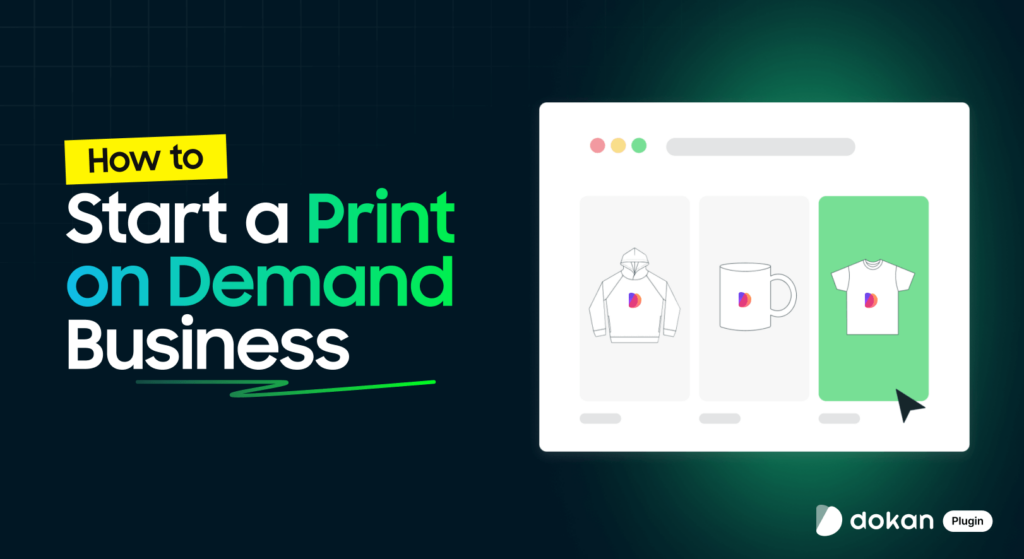
After reading all the advantages and disadvantages of the print on demand business, if you are ready to start, then this section is your guide.
Here are the steps to start your own print on demand business from today!
- Pick a Niche
- Decide What to Sell
- Create Designs
- Decide Where to Sell
- Set Up a Store
- Pick Your Supplier
- Set a Price
- Check the Quality of Your Products
- Market Your Products
- Monitor Your Online Store Performance
Let’s dive deep, shall we?
01. Pick a Niche
First and foremost, pick your niche (specialized market segment). This is the most important process of learning how to start a print on demand business. If you can lock your niche down, the other parts of the process will become easy.
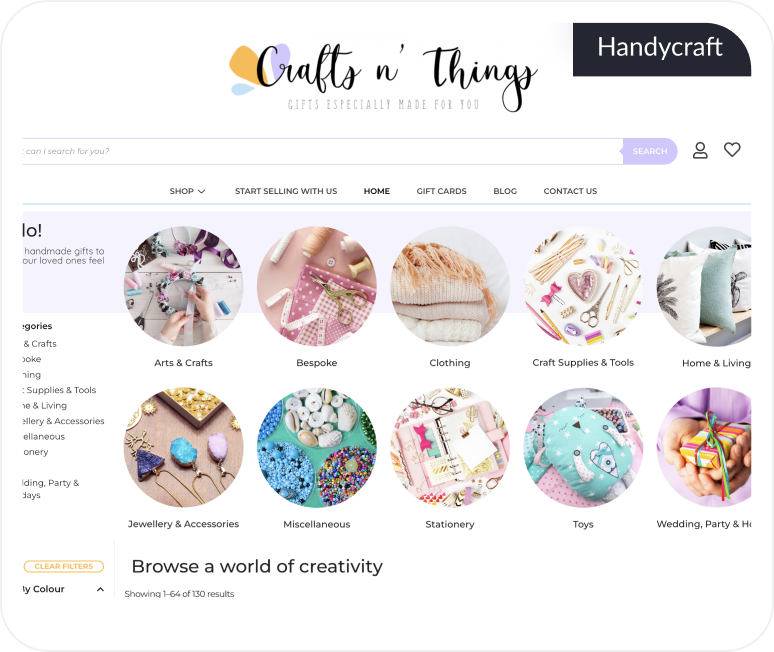
While picking your niche, you need to keep some things in mind. Your niche should have a higher profit rate, less competition, and less money spent on advertising. But our advice will be if you are passionate about something then pick that niche, no matter what the market situation is.
“If you feel like there’s something out there that you’re supposed to be doing, if you have a passion for it, then stop wishing and just do it.” — Wanda Sykes
If you are confused about what niche to pick, then you can read our guide on 50 Eco-Friendly Products with High-Profit Potential. Also, you can use Google Trends to see what products are trending and start from there.
02. Decide What to Sell
Suppose you have picked fashion as your niche. Now, it is time to decide what you are going to sell. Will you sell t-shirts, shirts, gowns, jumpsuits, or anything else from the fashion industry?
You can see some of the most popular items for a print on demand business-
- T-Shirts
- Die-Cut Stickers
- Hoodies
- Socks
- Custom Tote Bags.
But do keep your customers in mind while choosing your product. The product you choose should make sense in the niche you picked.
You can use Amazon, Etsy, eBay, etc to do your research. Also, take a tour of Facebook, Reddit, X, etc to get more ideas.
Want to Create an
Furniture Marketplace?
03. Create Designs
For a print of demand business, it is all about unique designs. But don’t worry, you don’t need to be a designer and have artistic skills to start a print on demand business.
There are lot of tools and software out there to create unique designs. You can also take help from AI as well. If you have the budget, you can hire professional designers as well.
Draw inspiration from sites like:
Only use your research as a starting point to create your own original designs. Never plagiarize or claim another creator’s work as your own.
Also, make sure your designs are not misunderstood by the audience. Check the design again and again.
04. Decide Where to Sell
You have picked your niche, decided what to sell, and created your design. Now it is time to decide where to sell your products. You can sell your products to popular platforms like-
- Printful
- Redbubble
- TeeSpring (Spring)
- Society6
- Zazzle
- TeePublic
- Spreadshirt
- Gelato
- Gooten
- CafePress
You can also go for proven platforms like Amazon, eBay, Etsy, etc.
But if you want to create your own store, then you can use popular solutions like-
- WooCommerce
- Shopify
- BigCommerce
- Magento
- PrestaShop
- Wix
- Squarespace
- Weebly
- Ecwid
- Big Cartel
By creating your own standalone shop, you will have full control over all things. Like branding, marketing strategy, and customer experience.
05. Set Up a Store
After picking the platform, now it is time to set up your store. Although setting up a store is different in different platforms, the process is very straightforward. You will have access to many pre-built templates that you can use to setup your store.
Enable essential features like payment gateways, shipping options, and customer service channels to ensure a smooth shopping experience for your customers.

Taking the time to set up your store properly is crucial to ensure the success of your business.
If you are using a readymade platform, then all you need to do is sign up, verify your information and you are good to go.
06. Pick Your Supplier
When starting a print-on-demand business, having a reliable supplier to fulfill your orders is essential.
Finding trustworthy print-on-demand companies is critical to the success of your online store, as your reputation as an entrepreneur depends on it.
We have talked about some popular print on demand suppliers in the later part of the article.
07. Set a Price
This is the tricky part. You have created the designs and set up your store. So it natural that you will feel that your products worth is more. But be realistic about it.
You need to set a competitive price for your products. A price that generates profit but doesn’t scare away the customers. Also, the price shouldn’t be too low so that customers think that the products are cheap.
To find a competitive price. check out what your competitors are doing. Also, keep an eye on the social channels to see what the customers are saying about the product prices of your competitors.
Important things to consider when setting a price:
- Shipping and production costs.
- Average price of similar products in the market
- Location of your customers.
Proper product pricing will help you get success.
08. Check the Quality of Your Products
You want customers to come back to you again and again. For that, you need to deliver quality products. This will make sure you have repeat customers.
The design should be on point, and the material you are using should be top-notch. The print on demand service you have chosen should have the customers’ trust as well. Timely delivery and high quality production are what customers expect from you.
09. Market Your Products
Marketing is key to your business’s success. It helps drive traffic, engage customers, and convert visitors into buyers. Here are some effective ways to market your print-on-demand business:
- Social Media Marketing: Build a presence, engage with users, and post fresh content to connect with your audience and grow your brand.
- Influencer Marketing: Partner with influencers whose followers match your ideal customers to quickly expand your reach and build trust.
- Content Marketing: Publish blogs, videos, and reviews to establish authority in your niche and drive organic traffic.
- Email Marketing: Build a mailing list to send personalized offers and updates to keep customers engaged and improve conversions.
- Paid Ads: Use Google Ads or Facebook Ads for targeted advertising to reach a wider audience and increase traffic.
How the customers will see your brand will depend a lot on how you market your products.

10. Monitor Your Online Store Performance
Regularly tracking your online store’s performance is crucial for business growth.
Use analytics tools to monitor key metrics like traffic, conversion rates, and user engagement. Analyzing this data helps you identify successes and areas for improvement, enabling informed decisions and strategy optimization.
Consistent performance monitoring allows you to quickly adapt to market trends, address issues promptly, and enhance the overall customer experience.
Best Practices for Starting a Print on Demand Business
You now know how to start your print on demand business. But, before you launch your store, here are some best practices to keep in mind-
I. Use a Print-on-Demand App
A print-on-demand (POD) app connects your eCommerce store with suppliers who fulfill orders on your behalf.
Popular POD apps like Printful, Printify, and Gooten make it easy to manage your product listings, track orders, and automate the printing and shipping process.
This integration saves time and ensures a seamless flow between your online store and the fulfillment service, helping you focus on marketing and customer service.
II. Always Order Samples
Before launching products, it’s crucial to order samples. Samples allow you to evaluate the quality of the print, fabric, and overall product.
This also gives you a firsthand experience of the supplier’s shipping times and packaging quality. It helps avoid negative customer feedback by ensuring that the products meet your standards.
III. Create Mockups of Your Products
High-quality mockups of your products give customers a clear visual idea of what they’re purchasing.
Many POD apps provide built-in mockup generators, allowing you to showcase your designs on various products. Mockups can be used across your store, marketing materials, and social media to attract customers and drive sales.
IV. Be Strategic About Shipping
Shipping is one of the key aspects that can affect customer satisfaction. Research shipping times and costs from your POD provider to ensure you can meet customer expectations.
It’s a good practice to offer multiple shipping options, including expedited shipping for faster delivery. Make sure to communicate clear shipping policies and times on your website to avoid confusion.
V. Avoid Copyrights and Check if Your Written Phrase is Trademarked
It’s important to ensure that the designs and phrases you use are free from copyright or trademark restrictions.
Copying on someone else’s property can lead to legal issues, account suspensions, and costly penalties. Tools like the U.S. Trademark Electronic Search System (TESS) can help you check if a phrase is trademarked.
VI. Add Scarcity — But Not to Every Product
Scarcity can create a sense of urgency and drive purchases. You can create limited-time offers or exclusive collections to encourage customers to act quickly.

However, avoid applying scarcity to every product, as it may feel inauthentic. Instead, strategically use it on select items or during seasonal campaigns.
VII. Check if Your Niche is Banned on Facebook
Before investing time and money into marketing on Facebook, ensure that your niche is not prohibited by their advertising policies.
Some niches, such as adult content, drugs, or misleading products, are restricted or banned from Facebook ads. Checking this beforehand will prevent your campaigns from being rejected and help you choose alternative platforms if necessary.
These practices will help you reach your goal in the print on demand business.
Bonus: 4 popular Print-on-Demand Services
Here are 4 popular print on demand services that you can integrate with your business-
a) Printful
Printful is a popular choice among print-on-demand sites due to its wide selection of high-quality products and partnerships with well-known brands like Gildan, American Apparel, and Bella+Canvas.
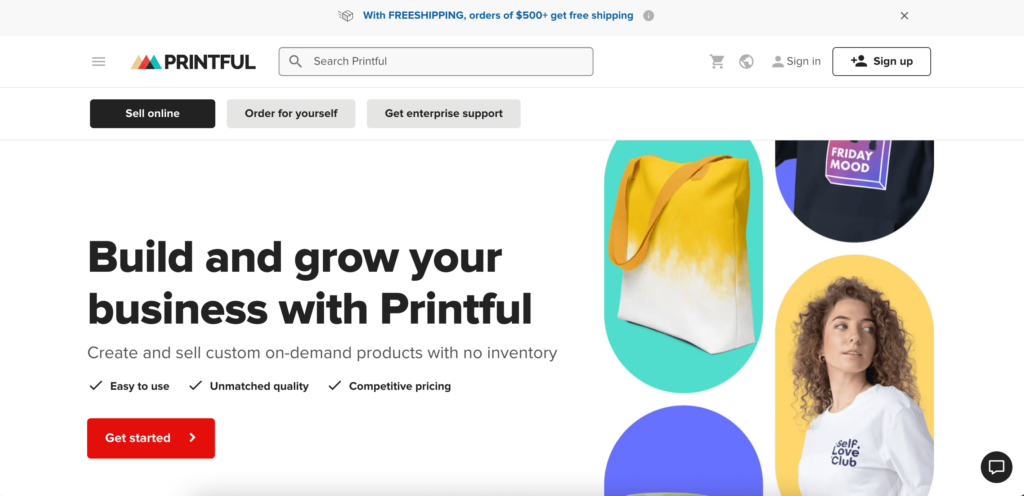
It also offers easy-to-use mockup generators, allowing sellers to preview designs before production, and provides options for adding custom branding, like labels and packaging, for a personalized unboxing experience.
For apparel products, Printful offers several printing techniques:
- Direct to Garment (DTG): Print is directly applied to the fabric, perfect for detailed designs.
- Cut and Sew: Fabrics are printed on first, then sewn together to ensure a continuous design.
- Embroidery: Uses thread to stitch the design for a more textured look.
Be mindful that customizations like adding prints on sleeves or inside labels may increase the price.
Aside from apparel, Printful provides a diverse catalog of products, such as mugs, pillows, bedding, framed posters, beach towels, aprons, and more.
b) Printify
Printify is another top choice in the print-on-demand space, offering a vast selection of products from multiple providers.
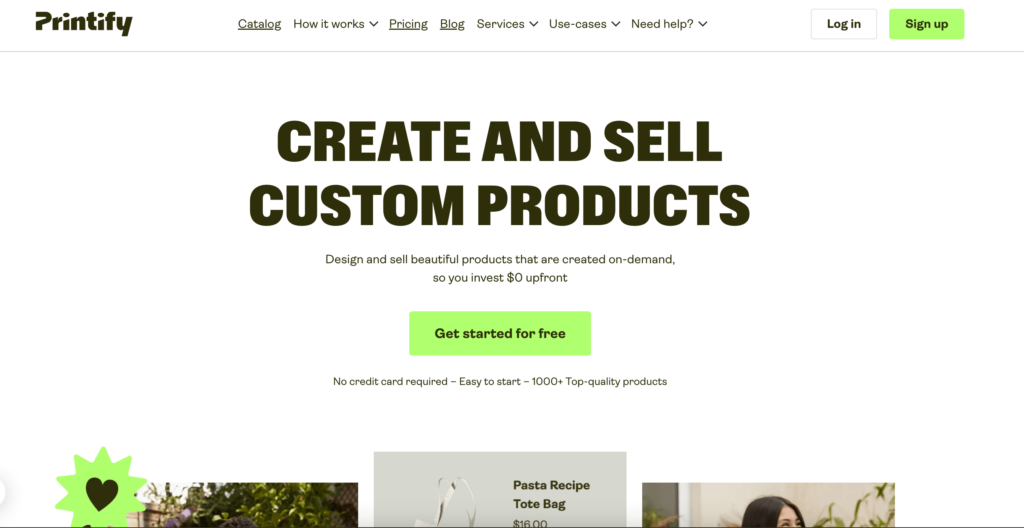
It connects with leading platforms like Shopify, Etsy, and WooCommerce, giving users flexibility in managing their stores. The platform also provides an intuitive design tool and allows merchants to brand their products with custom labels.
For apparel products, Printify supports various printing techniques:
- Direct to Garment (DTG): A popular option where designs are printed directly onto clothing for a smooth finish.
- Sublimation Printing: Ideal for all-over designs, this method transfers the design using heat and pressure, making it permanent and vivid.
- Embroidery: Designs are sewn onto garments for a premium and durable look.
It’s important to note that extra customizations, such as custom tags or specialty prints, may add to the base cost of items.
In addition to apparel, Printify offers a wide range of other products, including home goods, accessories, and stationery, making it a versatile option for sellers.
c) Gooten
Gooten is a reliable print-on-demand service, known for its global network of print providers and wide product catalog.
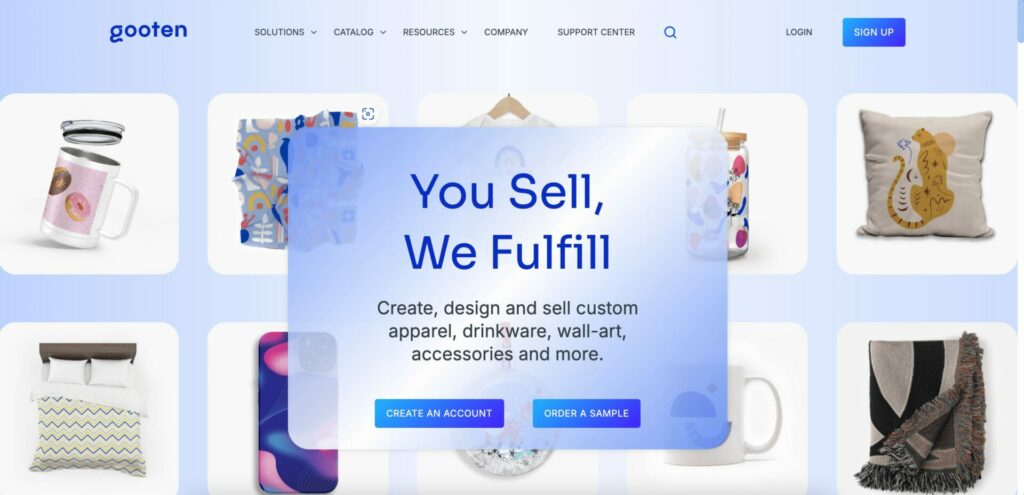
The platform integrates seamlessly with major eCommerce platforms, making it easy for sellers to manage orders. Gooten also offers mockup generators and branding options to enhance the customer’s experience.
For apparel products, Gooten provides several printing options:
- Direct to Garment (DTG): Prints detailed designs directly onto the fabric.
- Sublimation Printing: Transfers designs using heat and pressure for full-color, all-over prints.
- Embroidery: Adds a tactile, high-quality touch by stitching the design onto the fabric.
Like other platforms, customization options such as printing on additional areas or custom labeling might incur additional charges.
Beyond apparel, Gooten offers an array of products, from wall art and home decor to mugs and accessories, giving sellers a comprehensive selection to work with.
d) Lulu
Lulu xPress is a print-on-demand service primarily focused on book printing. It is a go-to platform for authors, publishers, and businesses looking for high-quality printed books.
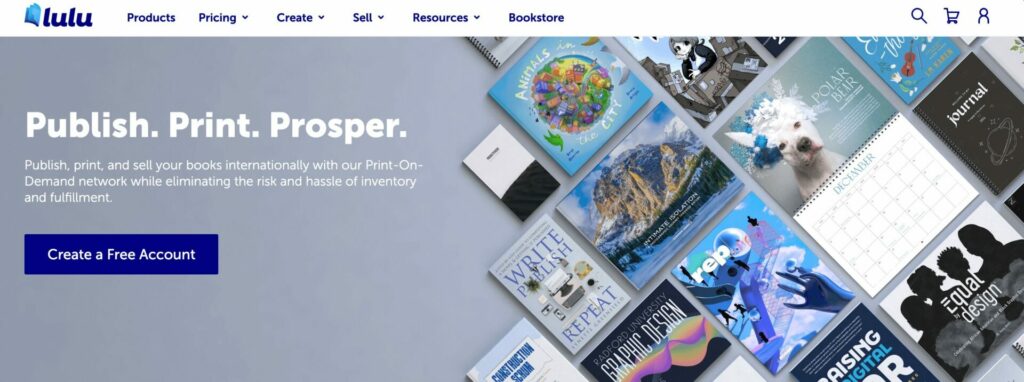
Lulu integrates with platforms like Shopify and offers customization options to ensure a unique unboxing experience for buyers.
For book products, Lulu offers several printing formats:
- Paperback: Softcover books with various binding options.
- Hardcover: Durable covers that are perfect for premium or special-edition projects.
- Photo Books: High-quality image printing for photography or art-focused books.
Though Lulu’s primary focus is books, there are customization options available, such as custom layouts and finishes, which may impact the overall cost.
Besides books, Lulu xPress offers additional printed materials like calendars, planners, and more, tailored for professionals looking to publish their work.
Ready to Start Your Print on Demand Business?
What do you think? Are you ready to start your own print on demand business?
This article will work as your guide to learning how to start a print on demand business. We have added all the necessary steps and resources you will require to start. And when done right, this business can become a very profitable venture.
If you are a content creator, artist, or entrepreneur, this is a go-to business model.
Interested in creating a print on demand marketplace? Read our guide on how to create a print on demand marketplace using Dokan!
If you have any questions regarding print on demand business, then do leave a comment in the below comment section. We will get back to you with an answer.
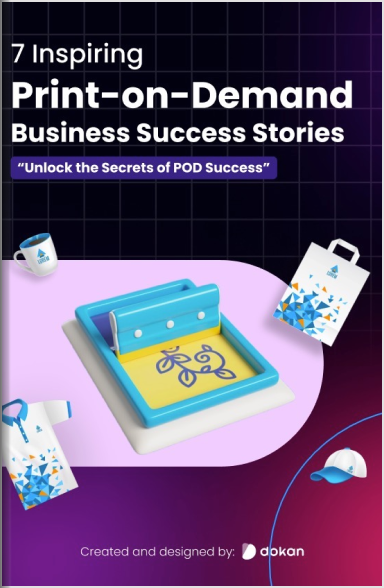
7 Inspiring
Print-on-Demand
Business Success
Stories
Unlock the Secrets of POD Success
Motivational Stories
Marketplace Ideas
Common Challenges
Checklist to Launch
Entrepreneurs’ Tips
How to Start Yours

Subscribe to
Dokan blog

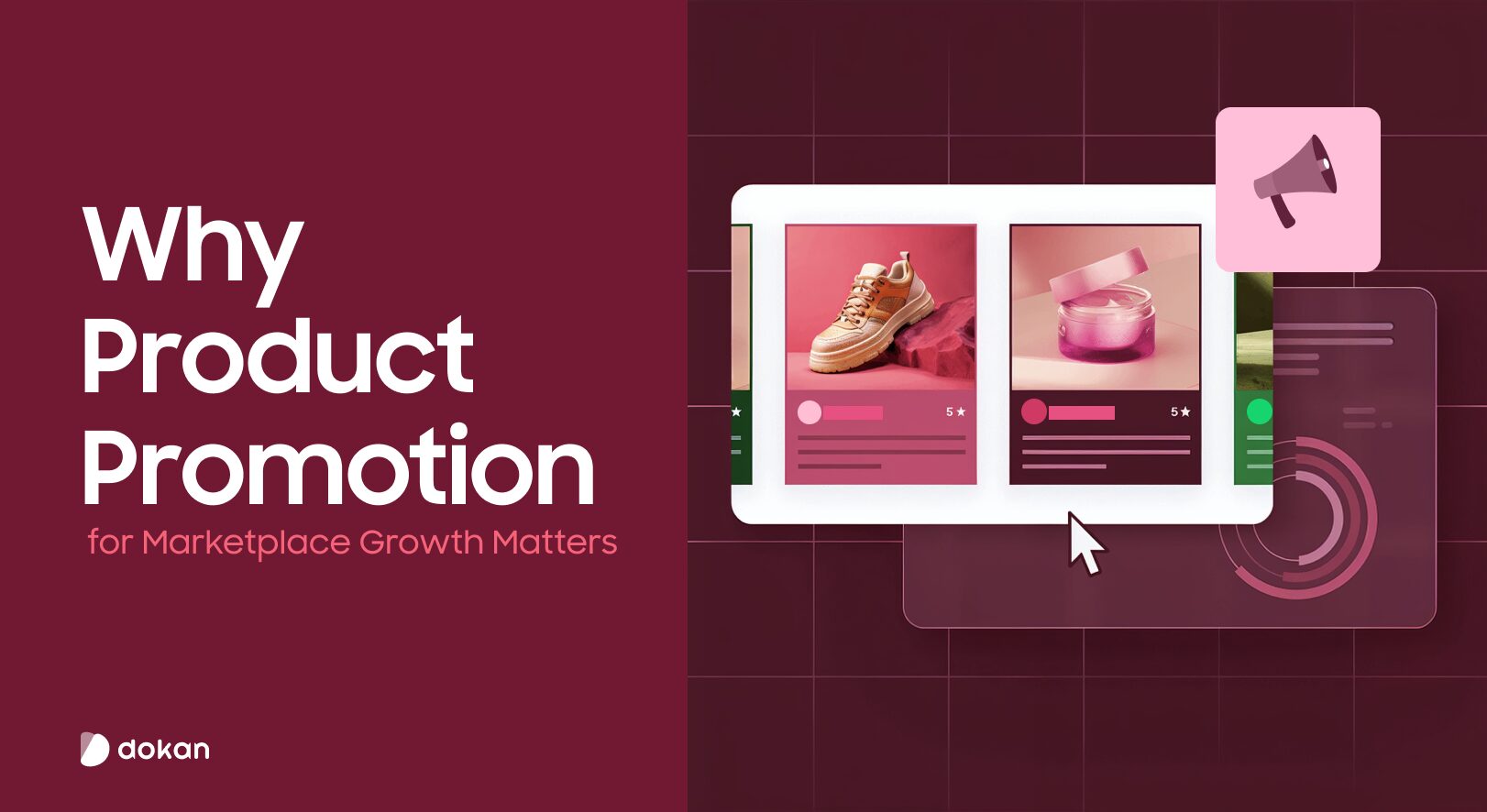


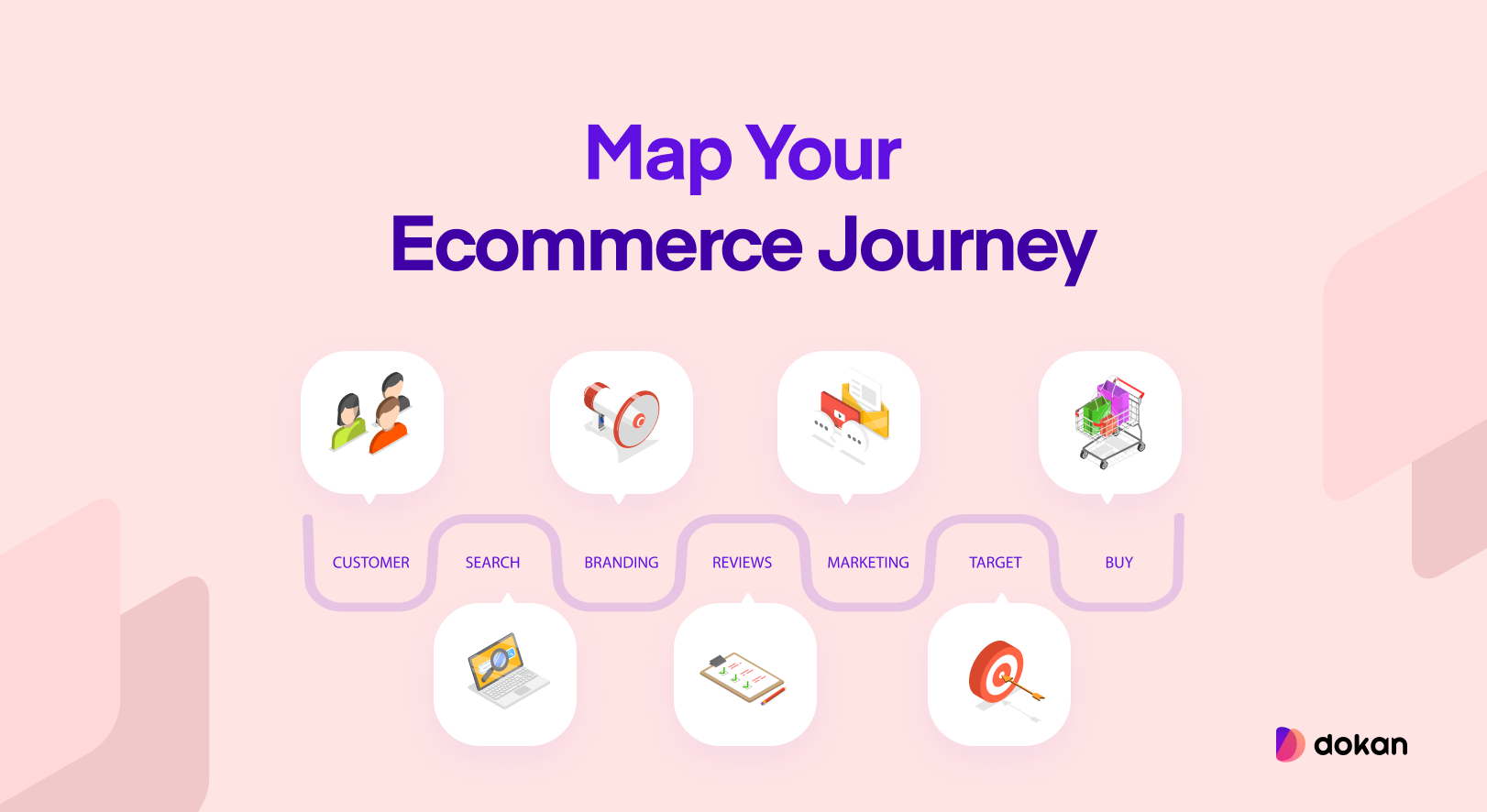

Leave a Reply